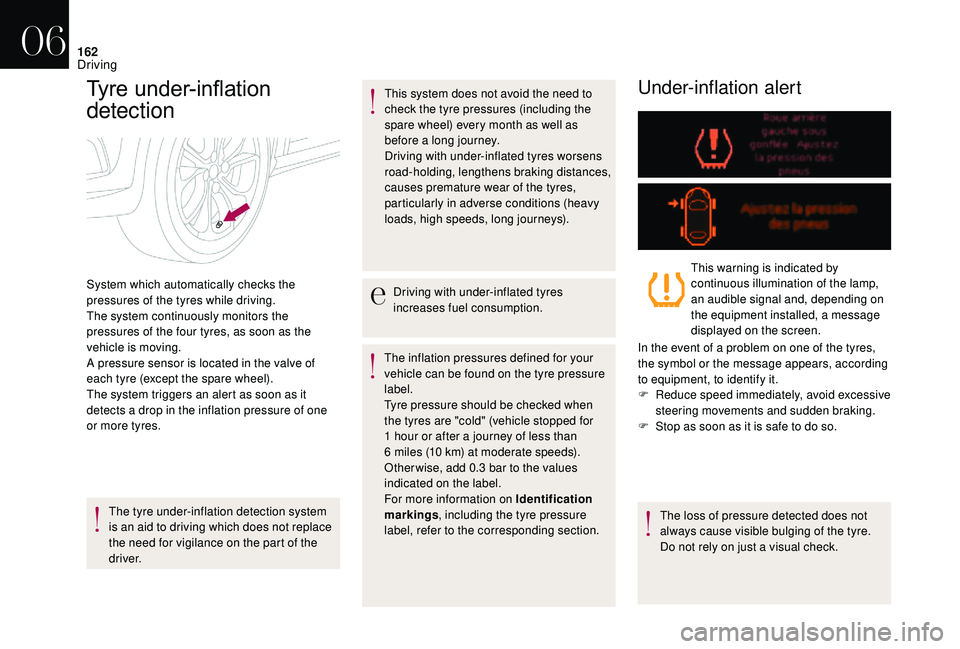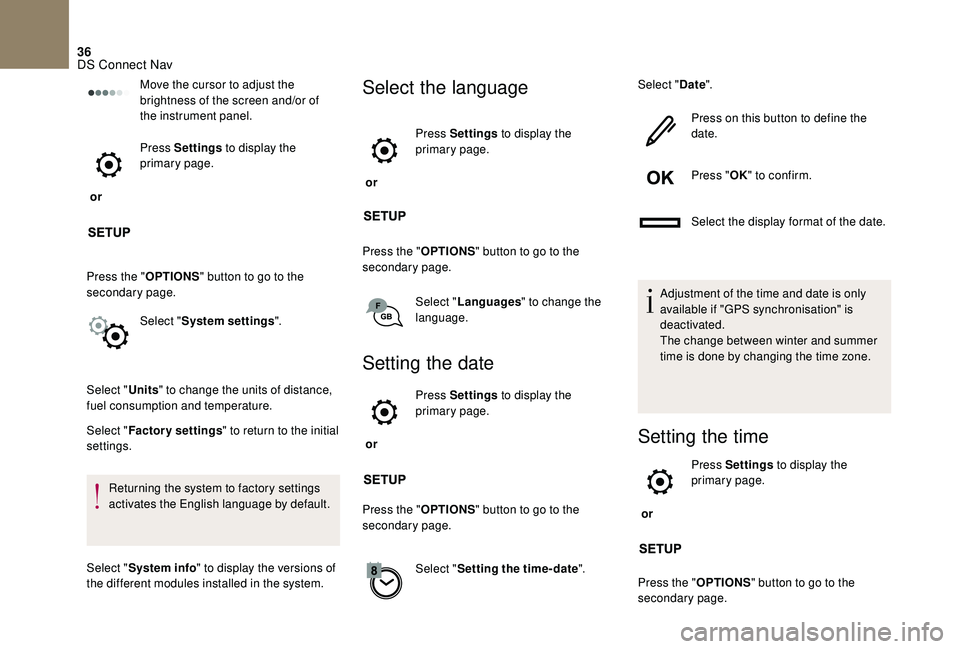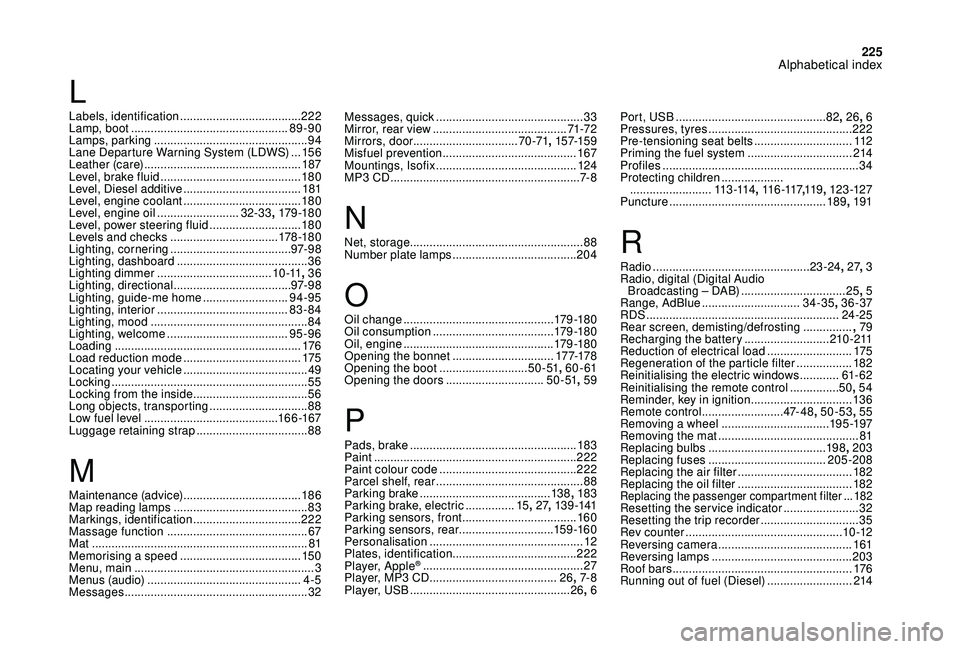fuel consumption CITROEN DS4 2023 User Guide
[x] Cancel search | Manufacturer: CITROEN, Model Year: 2023, Model line: DS4, Model: CITROEN DS4 2023Pages: 296, PDF Size: 9.91 MB
Page 164 of 296

162
Tyre under-inflation
d
etection
The tyre under-inflation detection system
is an aid to driving which does not replace
the need for vigilance on the part of the
driver. This system does not avoid the need to
check the tyre pressures (including the
spare wheel) every month as well as
before a long journey.
Driving with under-inflated tyres worsens
road-holding, lengthens braking distances,
causes premature wear of the tyres,
particularly in adverse conditions (heavy
loads, high speeds, long journeys).
Driving with under-inflated tyres
increases fuel consumption.
The inflation pressures defined for your
vehicle can be found on the tyre pressure
label.
Tyre pressure should be checked when
the tyres are "cold" (vehicle stopped for
1 hour or after a journey of less than
6 miles (10 km) at moderate speeds).
Other wise, add 0.3 bar to the values
indicated on the label.
For more information on Identification
markings , including the tyre pressure
label, refer to the corresponding section.
Under-inflation alert
System which automatically checks the
pressures of the tyres while driving.
The system continuously monitors the
pressures of the four tyres, as soon as the
vehicle is moving.
A pressure sensor is located in the valve of
each tyre (except the spare wheel).
The system triggers an alert as soon as it
detects a drop in the inflation pressure of one
or more tyres. This warning is indicated by
continuous illumination of the lamp,
an audible signal and, depending on
the equipment installed, a message
displayed on the screen.
In the event of a problem on one of the tyres,
the symbol or the message appears, according
to equipment, to identify it.
F
R
educe speed immediately, avoid excessive
steering movements and sudden braking.
F
S
top as soon as it is safe to do so.
The loss of pressure detected does not
always cause visible bulging of the tyre.
Do not rely on just a visual check.
06
Driving
Page 185 of 296

183
Manual parking brake
If excessive travel or a loss of
effectiveness of this system is
noticed, the parking brake must
be checked, even between two
services.
This system must be checked in the dealer
network or by a qualified workshop.
Electric parking brake
This system does not require any
routine servicing. However, in the
event of a problem, have the system
checked in the dealer network or by
a qualified workshop.
For more information on the Electric
parking brake , refer to the corresponding
section.
Only use products recommended by DS
AUTOMOBILES or products of equivalent
quality and specification.
In order to optimise the operation of
components as important as those in
the braking system, DS AUTOMOBILES
selects and offers very specific products.
After washing the vehicle, dampness, or
in wintry conditions, ice can form on the
brake discs and pads: braking efficiency
may be reduced. Make light brake
applications to dry and defrost the brakes.
AdBlue® (BlueHDi
engines)
To respect the environment and ensure
compliance with the Euro 6 standard, without
adversely affecting the performance or
fuel consumption of Diesel engines, DS
AUTOMOBILES has taken the decision to
equip its vehicles with a system that associates
SCR (Selective Catalytic Reduction) with a
Diesel particle filter (DPF) for the treatment of
exhaust gases.
SCR system
Using a liquid called AdBlue® that contains
urea, a catalytic converter turns up to 85% of
the oxides of nitrogen (NOx) into nitrogen and
water, which are harmless to health and the
environment.
Brake pads
Brake wear depends on the style
of driving, particularly in the case
of vehicles used in town, over short
distances. It may be necessary to
have the condition of the brakes
checked, even between vehicle
services.
Unless there is a leak in the circuit, a drop in
the brake fluid level indicates that the brake
pads are worn.
Brake disc/drum wear
For information on checking brake
disc wear, contact the dealer
network or a qualified workshop.
07
Practical information
Page 224 of 296

222
Identification markings
Various visible markings for the identification of
your vehicle.
A. Vehicle identification number (V.I.N.),
under the bonnet.
The number is engraved on the body structure.
B. Vehicle identification number (V.I.N.), on
the dashboard.
The number is on a label, visible through the
windscreen. C. Manufacturer's label.
This tamperproof label is affixed to the driver's
door aperture.
It bears the following information:
-
t
he name of the manufacturer,
-
t
he European Whole Vehicle Type Approval
number,
-
t
he vehicle identification number (V.I.N.),
-
t
he gross vehicle weight (GV W)
-
t
he maximum authorised vehicle + trailer
weight (the Gross Train Weight or GTW),
-
t
he maximum weight on the front axle,
-
t
he maximum weight on the rear axle.
D. Tyres/paint code label.
This label is affixed to the driver's door
aperture.
It bears the following information on the tyres:
-
t
he tyre pressures, unladen and laden,
-
t
he tyre specification, made up of the
dimensions and type as well as the load and
speed indices,
-
t
he spare tyre pressure.
It also indicates the paint colour code. The vehicle may be originally equipped
with tyres with higher load and speed
indices than those indicated on the label,
without affecting inflation pressure.
Checking tyre pressures
The tyre pressures should be checked when
cold at least monthly.
The pressures given on the label are valid for
cold tyres. If you have driven for more than 10
minutes or more than 6 miles (10 kilometres)
at more than around 30 mph (50 km/h), the
tyres will be warm; in this case 0.3 bar (30 kPa)
should be added to the pressures given on the
label. Never reduce the pressure of a warm tyre.
Low tyre pressures increase fuel
consumption.
09
Technical data
Page 260 of 296

36
Move the cursor to adjust the
brightness of the screen and/or of
the instrument panel.
or Press Settings
to display the
primary page.
Press the " OPTIONS" button to go to the
secondary page.
Select "System settings ".
Select " Units" to change the units of distance,
fuel consumption and temperature.
Select " Factory settings " to return to the initial
settings.
Returning the system to factory settings
activates the English language by default.
Select " System info " to display the versions of
the different modules installed in the system.Select the language
or Press Settings
to display the
primary page.
Press the " OPTIONS" button to go to the
secondary page.
Select "Languages " to change the
language.
Setting the date
or Press Settings
to display the
primary page.
Press the " OPTIONS" button to go to the
secondary page.
Select "Setting the time- date". Select "
Date".
Press on this button to define the
date.
Press " OK" to confirm.
Select the display format of the date.
Adjustment of the time and date is only
available if "GPS synchronisation" is
deactivated.
The change between winter and summer
time is done by changing the time zone.Setting the time
or Press Settings
to display the
primary page.
Press the " OPTIONS" button to go to the
secondary page.
DS Connect Nav
Page 291 of 296

225
Messages, quick .............................................33
M irror, rear view ......................................... 71-72
Mirrors, door ................................ 70 -71, 157-159
Misfuel prevention
......................................... 167
Mountings, Isofix
........................................... 124
MP3 CD
.......................................................... 7- 8
N
Net, storage..................................................... 88
Number plate lamps ...................................... 204
O
Oil change .............................................. 17 9 -18 0
Oil consumption ..................................... 179 -18 0
Oil, engine
.............................................. 179 -18 0
Opening the bonnet
...............................17 7-178
Opening the boot
...........................5 0 - 51, 60 - 61
Opening the doors
..............................5 0 - 51, 59
P
Pads, brake ................................................... 183
Paint .............................................................. 222
Paint colour code
.......................................... 222
Parcel shelf, rear
............................................. 88
Parking brake
........................................ 13 8, 183
Parking brake, electric
............... 15,
27, 13 9 -141
Parking sensors, front
...................................160
Parking sensors, rear .............................15 9 -16 0
Personalisation
............................................... 12
Plates, identification ...................................... 222
Player, Apple
® ................................................. 2 7
Player, MP3 CD ............................... ........26, 7- 8
Player, USB
................................................. 26, 6 Port, USB
..............................................82
, 26, 6
Pressures, tyres
............................................
222
Pre-tensioning seat belts
..............................
112
Priming the fuel system ................................
214
Profiles
............................................................
34
Protecting children
...................
.........................
113 -114, 11 6 -117 ,11 9 , 123 -127
Puncture
................................................
189, 191
R
Radio ................................................ 23 -24, 27, 3
Radio, digital (Digital Audio Broadcasting – DAB)
................................25, 5
Range, AdBlue
.............................. 34-35, 36 -37
RDS
................
........................................... 24-25
Rear screen, demisting/defrosting
............... ,
79
Recharging the battery
..........................210 -211
Reduction of electrical load
..........................175
Regeneration of the particle filter
.................182
Reinitialising the electric windows
............ 61
- 62
Reinitialising the remote control
............... 50,
54
Reminder, key in ignition
...............................13
6
Remote control
.........................47- 4 8, 50-53 , 55
Removing a wheel
................................. 195 -197
Removing the mat
........................................... 81
Replacing bulbs
.................................... 19
8, 203
Replacing fuses
.................................... 205-208
Replacing the air filter
................................... 18
2
Replacing the oil filter
................................... 18
2
Replacing the passenger compartment filter ...182Resetting the service indicator .......................32
Resetting the trip recorder ..............................35
Rev counter
................................................ 10 -12
Reversing camera
...............................
..........161
Reversing lamps
..............................
.............203
Roof bars
....................................................... 176
Running out of fuel (Diesel)
..........................214
L
Labels, identification ..................................... 222
Lamp, boot ................................................ 89-90
Lamps, parking
............................................... 94
Lane Departure Warning System (LDWS)
...15 6
Leather (care)
................................................ 187
Level, brake fluid
........................................... 18 0
Level, Diesel additive
.................................... 181
Level, engine coolant
.................................... 18 0
Level, engine oil
.........................32-33, 179 -18 0
Level, power steering fluid
............................18 0
Levels and checks
..............................
...178 -18 0
Lighting, cornering
..................................... 97- 9 8
Lighting, dashboard
........................................ 36
Lighting dimmer
................................... 1 0 -11, 36
Lighting, directional
.................................... 97- 9 8
Lighting, guide-me home
..........................94-95
Lighting, interior
...............................
.........83-84
Lighting, mood
................................................ 84
Lighting, welcome
..................................... 95-96
Loading
......................................................... 176
Load reduction mode
.................................... 175
Locating your vehicle
...................................... 49
Locking
...............................
.............................55
Locking from the inside
...................................56
Long objects, transporting
..............................88
Low fuel level
......................................... 16
6 -167
Luggage retaining strap
.................................. 88
M
Maintenance (advice) .................................... 18 6
Map reading lamps ......................................... 83
M
arkings, identification
.................................222
Massage function
........................................... 67
Mat
.................................................................. 81
Memorising a speed
..................................... 15
0
Menu, main
....................................................... 3
M
enus (audio)
............................................... 4-5
Messages
........................................................ 32
Alphabetical index